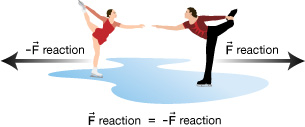Module 3—Effects of Force on Velocity
 Explore
Explore
Newton’s Third Law
Lex III: Actioni contrariam semper et æqualem esse reactionem: sive corporum duorum actiones in se mutuo semper esse æquales et in partes contrarias dirigi.
The modern translation of this law is that all forces occur in pairs, equal in magnitude and opposite in direction. Expressed as an equation, it is
![]()
 Lesson 2 Lab: Newton’s Third Law
Lesson 2 Lab: Newton’s Third Law

In simple terms, Newton’s third law means that if one object exerts a force on another, the other object simultaneously exerts an equal force back on the first object. For example, if a skater pushes on a smaller skater with ![]() , then the smaller skater pushes back on the larger skater with
, then the smaller skater pushes back on the larger skater with![]() , which is equal in magnitude but opposite in direction.
, which is equal in magnitude but opposite in direction.
The applet used for this lab lets you simulate two skaters pushing away from one another. You can learn more about the simulation and how to use it by reading Show Me found at the top of the simulation screen.
Problem
If one object exerts a force on another, will the other object simultaneously exert an equal force back on the first object?
Open the Momentum Conservation simulation that will demonstrate Newton’s third law; then continue with the procedure. You may be required to login with a username and a password. Contact your teacher for this information, if needed.
Procedure
- Reset the applet by pressing “Reset” (
 ).
). - Press the “Data” button (
 ) to display information about each skater.
) to display information about each skater. - Press “Play” (
 ), and observe the skaters moving apart. Keep the mass of skater 1 at 60.0 kg and the mass of skater 2 at 45.0 kg.
), and observe the skaters moving apart. Keep the mass of skater 1 at 60.0 kg and the mass of skater 2 at 45.0 kg.
Observations and Analysis
 Module 3: Lesson 2 Assignment
Module 3: Lesson 2 Assignment
Remember to submit the answers to LAB 1, LAB 2, LAB 3, and LAB 4 to your teacher as part of your Module 3: Lesson 2 Assignment.
LAB 1. Record the information from the following chart, and complete the calculations for skater 2. (The calculations for skater 1 have been done for you as examples.) Let motion to the right be positive and motion to the left be negative.
Skater 1 |
Skater 2 |
initial velocity = 0.00 m/s |
initial velocity = 0.00 m/s |
final velocity = –0.23 m/s |
final velocity = ___________ |
change in velocity = –0.23 m/s |
change in velocity = ___________ |
time interval over which the force is applied = 0.10 s
|
time interval over which the force is applied = 0.10 s
|
calculate the acceleration of skater 1 |
calculate the acceleration of skater 2 |
mass of skater 1 = 60.0 kg |
mass of skater 2 = __________ |
calculate the force applied to skater 1
|
calculate the force applied to skater 2
* Round your answer to 2 significant digits. |
LAB 2. What do you notice about the magnitude of the force applied to each skater?
LAB 3. What do you notice about the direction of the force applied to each skater?
LAB 4. Restate Newton's third law using the force values you calculated for each skater.
Conclusion
You saw that each skater was acted on by a force. You also saw that the magnitudes of these two forces were equal. The difference in the forces was their directions, which were opposite, and the fact that each force acted on a different person.

